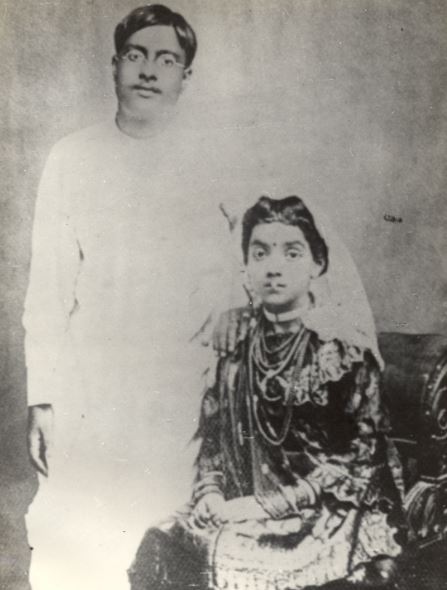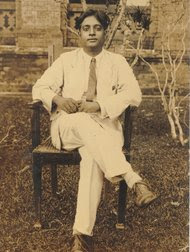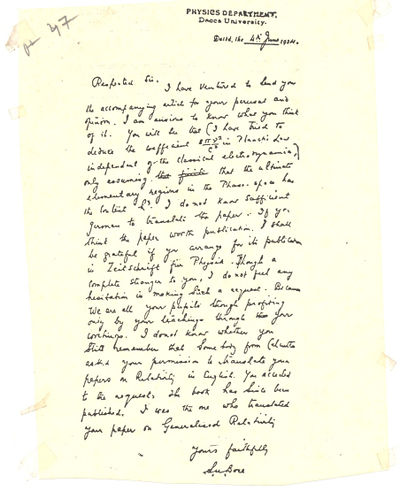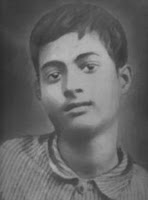
Half the particles in the universe obey him: This is how a professor of physics once introduced Satyendra Nath Bose to his students. Bose was a self-taught scholar and polymath who laid the foundation for Bose-Einstein statistics and the theory of the Bose-Einstein condensate.
Several Nobel Prizes were awarded for research related to the field initiated by him but Bose himself was not awarded the most coveted Prize. Yet, it is true that half the particles in the universe obey him and that in itself is a remarkable achievement.
Early Life
Satyendra was born on January 1, 1894 to a middle-class Bengali family in Calcutta. He was the eldest of seven children with six sisters after him. At an early age, Bose showed an aptitude for learning and a thirst for knowledge.
Surendra Nath, an accountant by profession, encouraged his son's mathematical skills. Each morning, he would leave arithmetic problems scribbled on the veranda floor, and a young Bose would sit and do his sums and proudly show his father when he returned.
When he was 13, Satyendra began attending the illustrious Hindu School in Central Calcutta. Bose was quickly recognized as an outstanding pupil especially in mathematics and the sciences. He was also fortunate to have had brilliant teachers and class fellows.
 |
| Hindu School |
Meanwhile in the west, Albert Einstein had become a much celebrated scientist thanks to the success of Special Relativity in 1905.
While at Presidency College, Satyendra came under the guidance of teachers like Sir Jagadish Chandra Bose and Sir Prafulla Chandra Ray. A 17-year-old Bose thrived his intermediate examination, then chose Applied Mathematics for Bachelor of Science Degree, graduating two years later in 1913, at the top of his class.
 |
| The Hub of Learning |
Just one year later (1914), at age 20, newly graduate Satyendra was married to Ushabati Ghosh, the eleven-year-old daughter of a prominent Calcutta physician. This was before the passing of Child Marriage Restraint Act which had fixed the age of marriage for girls at 18 years and boys at 21 years.
The marriage had been arranged by Bose's mother, Amodini Rai Chaudhuri. Bose would rather have married later but went along with his mother’s wishes. He refused to accept dowry for his marriage in a time when it was commonly practiced, and set about to teach the English language to Usha afterwards.
 |
| A young couple |
Bose also continued his education by enrolling for Master's Degree in Applied Mathematics at University of Calcutta. In 1915, at age 21 he not only graduated at the top of his class but also created a record in the history of the University by securing 92% marks!
During this time, World War I had begun in the west. Also, Albert Einstein had successfully published his Theory of General Relativity.
During this time, Bose came across the newly published theory of general relativity. He was instantly fascinated by it, so much so that along with colleague and friend, Meghnad Saha, Bose went on to translate Einstein's scientific papers from German to English and published them in a book.

As a polyglot, Bose was well versed in several languages such as Bengali, English, French, German and Sanskrit.
In 1921, Albert Einstein was given the prestigious Nobel Prize for his services to theoretical physics, and especially for his discovery of the Law of the Photoelectric Effect, a pivotal step in the development of quantum theory. Bose in Calcutta was overjoyed by the victory of his hero.
The Breakthrough
The same year (1921), Satyendra left his beloved Calcutta and took up a position at Dhaka University, in present-day Bangladesh, where he was Reader (associate professor) for the Physics Department. In a letter written to his friend Meghnad Saha, Bose described the situation at the University:
It has been well over a month since I moved to your part of the country. Work has not yet started. Your Dacca College had quite a few things but due to utter neglect they are in a bad way. We do suffer from lack of journals here, but the authorities of the new University have promised to place order for some of them along with their back numbers. Talk is going on about having a separate science library.
Bose helped in setting up whole new departments at the University, including laboratories, for teaching advanced courses to undergraduate and postgraduate students of Physics and Chemistry. And as Reader, he gave lectures on Thermodynamics and Classical Electromagnetism.
 |
| In Dhaka |
During one such lecture, Bose felt dissatisfied with the existing derivations of Plank’s Radiation Law. After much thought and several discussions with Saha, Bose came up with a paper deriving the same result without the use of classical physics as Planck himself had done. This was a breakthrough!
Bose's derivation was rejected at first, because it was a radical idea which couldn't be accepted just about by anyone. Bose was not disheartened though as he sent the paper directly to Albert Einstein in Germany.
 |
| Bose's letter to Einstein |
In a way, Bose helped revive Einstein's falling scientific career. This was the mid-1920s and Einstein was deeply involved in opposing the ongoing quantum revolution, despite him having pioneered it. Bose's letter came like a breath of fresh air catching the attention of the great scientist.
Einstein was quick to recognize the importance of the received letter. He translated Bose's paper into German and had it published in Zeitschrift für Physik, a popular peer-reviewed German scientific journal of the time, under Bose's name, in 1924. Hence, Bose-Einstein statistics was born!
Einstein was greatly impressed that a certain young man from India had reached out to him for the sake of scientific progress. Einstein wrote to Bose: Your paper is an important step forward and I liked it very much.
 |
| Reverence |
The more Einstein thought about Bose's paper, the more influenced he became by its implications. The reason Bose's interpretation produced accurate results was that since photons are indistinguishable from each other, one cannot treat any two photons having equal energy as being two different photons.
Understanding this is pretty easy: consider the situation when you have to toss two distinguishable and unbiased coins at the same time. Then there may come one of the four possible outcomes as shown by the following picture.

In this way, the probability of getting Two Heads is merely 1/4, which is of course obvious. But suppose that the two coins become indistinguishable from one another, that is, by looking at them you cannot tell the difference.
Then, there will be three possible outcomes only: Two Heads or Two Tails or One of Each. Now the chance of getting Two Heads is increased to 1/3. This means that in the world of Bose statistics, the likelihood of events happening is quite different from our everyday expectations.
Einstein had started to realize just how important this proposition was. In fact, Bose himself had not been aware of the potential of his idea. Einstein adopted Bose's idea and extended it to atoms. This led him to predict the existence of phenomena which we now call Bose-Einstein Condensate.
Bose-Einstein condensate is the fifth state of matter in which every atom becomes indistinguishable from the others forming a giant super atom. In a normal gas, atoms move randomly at very high speeds but in the case of Bose-Einstein Condensate, the atoms stay together in a perfect harmony.
In 1995, 70 years after its prediction, the Bose-Einstein Condensate was first observed to exist. This was achieved by cooling a gas of Bosons to very close to Absolute Zero, at which point the microscopic quantum phenomena, particularly wavefunction interference, become apparent macroscopically!Bose's work had earned him an invitation to collaborate with the greatest minds of the time in Europe. Bose applied for a two-year leave from the Dhaka University to enable him to go to Europe. He was permitted only after he showed Einstein’s appreciative postcard to the Vice Chancellor of the University.

After arriving in Paris, Bose wrote to Einstein.
I have been granted leave by my University for two years. I have arrived just a week ago in Paris. I do not know whether it will be possible for me to work under you in Germany. I shall be glad, however, if you will grant me the permission to work under you, for it will mean for me the realization of a long-cherished dream.
Bose waited eagerly for the great scientist to respond. In the meanwhile, he was fortunate to have helped the legendary Marie Curie in her lab work where he made certain difficult measurements of the Piezoelectric Effect. Bose also met Maurice de Broglie later, who introduced him to X-ray diffraction and spectroscopy. And at last, Einstein's reply came in.
Thank you sincerely for your letter. I am glad that I shall have the opportunity soon of making your personal acquaintance.
Bose proceeded to Berlin. Even though he did not get the opportunity to work with Einstein, his meeting with him was quite profitable. Einstein wrote a letter of recommendation for Bose which enabled him to meet some of the best German scientists including Fritz Haber, Lise Meitner and Max Born.
 |
| In good company |
After his stay in Europe, Bose returned to Dhaka in 1926. He was 32 years old. Bose did not have a doctorate and as a result, he would not be qualified for the post of Professor he had applied for. But again, Einstein's letter of recommendation was much help. Bose was declared Head of the Department of Physics at Dhaka University.
Whatever Bose had learned in Europe, he applied it in Dhaka. Bose designed equipment himself for an X-ray crystallography laboratory. He also set up laboratories and libraries to make the department a center of research in Unified Field Theories. Bose continued to teach at the University until 1945.
 |
| Partition |
When the partition of India became imminent, Bose returned to Calcutta. He was depressed by the division of India and Pakistan and felt it to be a wound in the heart of his beloved nation. Bose found it very difficult to focus on the sciences in the middle of this social imbalance. Bose decided to stay in Calcutta and taught there until retirement.
Bose’s path breaking work won him Einstein’s admiration and a permanent place in the history of theoretical physics. But few know about his passionate patriotism or his talent as an Esraj player. He was a man who tried to see the world around him in its entirety, in its complexity and in which his particular science and himself were but small parts.
 |
| A celebrated Esraj player |
Bose devoted a lot of time to promoting Bengali as teaching language, translating scientific papers into it, and promoting the development of the region. He strongly felt that it was duty to present science to the common man in his own language. Being Bengali, Bose was devastated by the division of Bengal on the basis of religion in 1905.
Retirement
Bose was made Professor Emeritus on his retirement. He was 62 years old. Then followed innumerous invitations to big events and parties but Bose dearly missed the pleasure of finding things out, the never ending quest for knowledge and the kick in the discovery.
He returned to the University of Calcutta to continue research in nuclear physics, organic chemistry and unified field theories. This seeking he enjoyed the most. It was during this time that physicist Paul Dirac had come to visit Calcutta along with his wife.
They were sharing the same car with Bose. Bose let them have the pleasantly warm back seat. The front seat, which Bose occupied along with the driver, did not have much room, nevertheless, Bose asked two more of his students to get in.
Dirac, a little surprised, asked if it wasn’t too crowded. Bose turned around and said in his disarming fashion, "We believe in Bose-Einstein statistics."
 |
| Dirac and Bose |
Dirac explained to his wife, "In Bose-Einstein statistics things are crowded together." The term Boson was coined by Dirac to commemorate the contributions of Bose in theoretical physics. Such was their friendship.
In 1958, Bose was elected Fellow of the Royal Society, finally. A year later, he was appointed as National Professor by the Government of India, a post he held till his death. As mentioned before, Bose was never awarded the Nobel Prize. When Bose himself was asked about the same, he simply replied, "I have got all the recognition I deserve."
Bose died in Calcutta, 1974, aged 80. With his death, an era ended. It would not be wrong to address Bose as the greatest Indian physicist of all time. Not just because he was a great scientist but also because he loved his country dearly. It is quite unfortunate that Bose's name is not mainstream popular in India. But things are changing now.









 Physics, astronomy and science history blog for students
Physics, astronomy and science history blog for students
Responsive Ad Slot